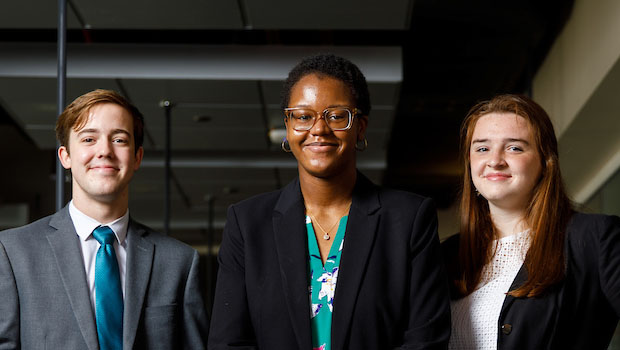
There are 40,000 burn injuries that require hospital care annually in the United States. Treatment is lengthy and expensive. What if healing could be faster, cheaper and improve patient outcomes?
What if NASA technology could be used to help?
A team of undergraduate students at The University of Alabama tackled this issue recently as part of a partnership with NASA to turn technology discovered by the space agency into viable products. Part of the STEM and CREATE PATH to MBA programs in UA Culverhouse College of Business, the NASA Technology Transfer University program, or NASA T2U, allows freshman and sophomore students to use NASA intellectual property to solve existing challenges.
“Working on the NASA patents means doing a lot of not only technical research but market research,” said Lauren Davis, a native of Dacula, Georgia, studying mechanical engineering and part of the STEM PATH to MBA Program at UA. “We had to understand the problems with treating burn wounds while also coming up with a business model that includes knowing the market and how to prototype.”
During this seven-week innovation project, students build market assessments and business plans by working with a high-tech patent portfolio. In addition, students receive access to the NASA scientists and innovators, giving them a unique look into the details of the technology.
“The T2U NASA projects that we do are typically the students’ favorite projects and result in the most company startups and Aldag Business Pitch Competition teams that come from the STEM/CREATE program,” said Dr. Robert Morgan, director of the MBA Path programs and professor of marketing. “I think most Americans, but especially college-aged Americans, admire what NASA represents and get excited to be a part of NASA’s mission.”
Students gain the ability to start with technical details of a patent and finish by communicating a viable business proposal, which is part of what makes the UA program attractive to both students and employers, said Harold Wright, a clinical instructor in the STEM and CREATE Path Program who mentors students in the NASA T2U experience.
“They take this incredibly complex information and turn it into solutions for real-world problems,” Wright said. “These students are in demand because of learning that ability to make the complex simple, and that is useful for whatever they might do after graduation.”
One of the biggest advantages of working with the NASA patents is the experience of being part of a team, said André Farnet, who is studying mechanical engineering and part of the STEM Path to MBA Program.
“Communication is a big thing because you have to be able to talk with the other people you are working with who cover different areas of the project,” said Farnet, who is from New Orleans, Louisiana. “It all comes together at the end, and then you learn how to communicate to others your ideas.”
Farnet’s NASA T2U team this past spring worked with a NASA patent on a method of forming human tissue through a high-density spot seeding of skin cells, which can be layered to form three-dimensional tissue.
The students decided to use the patent for lab-engineered tissue and couple it with advancements in the treatment of burn wounds with fish skin. This method would make the tissue more effective at aiding the healing of burn wounds and answer a medical need while opening up business opportunities.
Fusion team member Abby Fickel, a native of Hartland, Wisconsin studying physic and psychology in the pre-med track, said the NASA T2U program has shown her more about the field of biomedical research.
“It combines what I learn in the classroom with what we learn through the program so we can see an impact on real-world problems,” she said.
Contact
Adam Jones, UA communications, 205-348-4328, adam.jones@ua.edu
